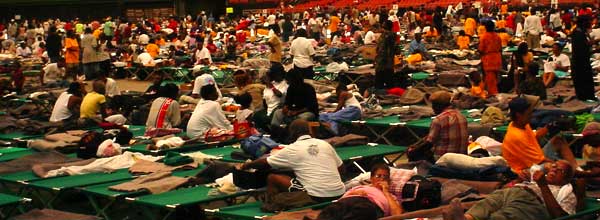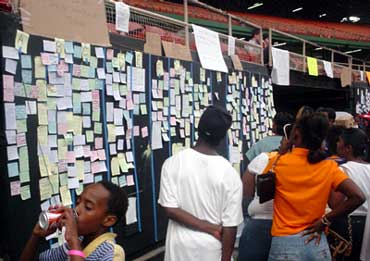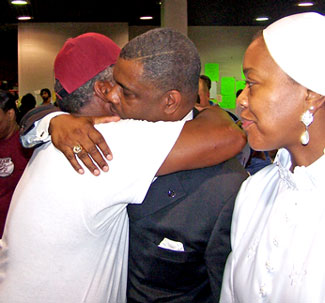Hurricane Katrina: Heartbreak and despair
By Jesse MuhammadStaff Writer | Last updated: Sep 8, 2005 - 11:42:00 PM
What's your opinion on this article?
- Click here for information on Hurricane Relief Efforts
- BET telethon to benefit for hurricane victims Sept. 9th (FinalCall.com News)

Thousands of evacuees from the New Orleans Superdome filled the floor of the Houston Astrodome.
|
HOUSTON (FinalCall.com) - Like most residents of New Orleans, Stephanie Simon thought Hurricane Katrina was a usual storm just passing through, but awakened in shock to see her neighborhood submerged in water.
“We have nothing now! Bodies were floating everywhere,” said Ms. Simon, one of thousands temporarily residing in the Houston Astrodome. She rescued her drowning mother and aunt who were unable to swim to safety on their own. With her 2-year-old baby wrapped under her arm, she headed for higher ground in hopes of receiving help. But that hope turned into frustration and long hours.
“My 2-year-old and I slept on the concrete bridge for two days,” she told The Final Call, while holding tears back. “Buses were just passing by us and not helping.”
Ms. Simon’s story is the condition of hundreds of thousands of Louisiana residents who have been displaced throughout the country as a result of Hurricane Katrina ripping through the Gulf Coast on Aug. 30.

Evacuees flock to the message board at the Astrodome to search for messages left from separated family members. Photos: Jesse Muhammad
Those who were unable to make the journey to the dome, slept on bridges, made �help� signs on rooftops, only to have their cries unheard. |
Residents believed they had survived the third most intense hurricane ever to pound U.S. shores. But they were unaware that the worst was yet to come.
On the northern edge of New Orleans at Lake Ponchartrain, a 15-foot levee made of earth and concrete began breaking. The initial break of about 10 feet widened to more than 200 feet to unleash a deadly waterfall into the city that is situated like the bowl of a valley. Efforts to drop sandbags into the break failed, as water filled the city streets. Mayor C. Ray Nagin realized that the huge breach at 17th Street Canal could not be immediately closed and declared that much of the city would have to be evacuated. To avoid the water, frightened residents began climbing onto rooftops, although many did not respond in time, and drowned in the waters that were rapidly rising.
Government officials declared a state of emergency for Lousiana, Alabama and Mississippi. Rescue workers desperately battled with a host of hurricane-related problems including floating dead bodies, evacuation of thousands of patients and prisoners, and uncontrollable fires that brought tears to Louisiana Governor Kathleen Blanco (D-La). “This situation is untenable and just heartbreaking,” she lamented.
Katrina swept through parts of Mississippi, where the death toll has surpassed 100. In the town of Biloxi, buildings were flattened, including an occupied beachfront apartment that collapsed under a 25-foot wall of water. At least three floating casinos were washed inland. Several small towns were completely wiped off of the map, with not one house standing. Many residents returned to their homes only to find dirt and debris. Those who survived the pulverization of the Mississippi Gulf Coast began to call the storm “our tsunami.”
“This storm overwhelmed our infrastructure,” said Mississippi Governor Hailey Barbour.
Several deaths were reported in Alabama, Florida and Georgia, as millions were left without electricity. With nearly 80 percent of New Orleans under water, national agencies launched a full scale rescue mission to search for survivors and bring them to safety. National Guards pushed dead bodies aside to reach people stranded on rooftops and in their own attics. The Red Cross described their efforts as the largest relief mission in history.
Hurricane Katrina has caused the largest displacement of people in American history. The shipping of major resources from Louisiana ports has been halted and gas prices continue to increase weekly with some cities gouging at the pump, as the destruction eliminated 25 percent of the oil and gas production for the country.
Despair in the Superdome
The scene in New Orleans became chaotic as thousands of people waited for buses to spirit them away from the destruction of Katrina’s touch. Many flocked to the Louisiana Superdome for safety and comfort until relief came. Over 20,000 unbathed, exhausted and hungry persons crammed into every nook and cranny of the facility, seeking sanctuary, but quickly found more stress and despair.
With insufficient staff, lack of supplies and unoperational air conditioning, the domed stadium became a horror. Toilets overflowed with feces, showers were broken, and evacuees inhaled the stench of rotten garbage. Unable to cope, many began to die in their sleep, and angry citizens became impatient with the slow response by the government.
Those who were unable to make the journey to the dome, slept on bridges, made “help” signs on rooftops, only to have their cries unheard.
Widespread looting of flooded stores started controversial reports by media that Blacks were “looting” and Whites were “finding”—media spin that drew angry criticism across the country. Thousands sat in bumper-to-bumber traffic to flee the city.
In response to request by Gov. Blanco, Governor Rick Perry (R-Texas) agreed to house 23,000 victims from the Superdome inside the famed Reliant Astrodome. Residents would board 500 buses and looked forward to the 350-mile journey away from the misery of Katrina—but faced unwanted trials in evacuating Louisiana.
The Red Cross set up a processing center and volunteers prepared cots in the center of the arena. A station to post notes of lost family members was set up to assist those misplaced. After the first 2,000 evacuees arrived at the Astrodome, a shooting took place at the Superdome that delayed the evacuation. Reportedly, one of the residents started shooting at the rescue helicopters. Witnesses of the shooting reported to The Final Call that the shooting occurred because Black people were tired of being overlooked and discriminated against while Whites were being assisted and picked up. Once the issue was resolved, evacuees were loaded onto buses one by one.
“You wouldn’t believe how unorganized the National Guard is,” shared Robert Guice IV, a Houston busdriver with Black-owned Skyline Charters. “I saw total frustration on the faces of the people. They were flocking to us with questions because they were not telling the people anything.”

Nation of Islam Minister Robert Muhammad is embraced by an evacuee at the Convention Center.
|
Mr. Guice was part of the caravan that brought the first thousand people to the Astrodome and described how Black people were being treated harshly. Robert Guice Jr., owner of Skyline Charter, shared with The Final Call that FEMA promised all volunteer bus companies that there would be tankers in New Orleans for them to refuel. “There were no tankers at all in New Orleans,” he reported. “So we paid out of our pockets because they promised to reimburse us.”
When he approached FEMA officials about reimbursement, they told him it would take 30 days.
“See, these people really don’t care,” he charged.
Many traveling in cars and trucks received word of help provided in Houston and headed to the Astrodome. One man took a bus and began picking up people on bridges to take them with him to Houston. When many arrived in their vehicles, to their dismay they were turned away because authorities were only allowing evacuees on FEMA buses to enter. This caused more frustration as evacuees filled the parking lots of neighboring stores in search of refuge.
Volunteers began to bring truckloads of donations to the Astrodome, but were turned away as well from providing immediate help. As a result, several groups began distributing relief items in store parking lots, but complained about not having access to the dome area.
With only 4,000 people inside, the final 400 buses arrived to receive some shocking news. The Houston Police Department (HPD) made a statement that the dome had reached capacity and that they were no longer accepting evacuees. It was also stated that the Fire Marshals Department had advised them that it would be a fire hazard to allow any more people inside. Busdrivers were ordered to take the people to another city, despite the promise that at least 23,000 people would be received.
Evacuees were held on the buses for several hours in the dome parking lot, while busdrivers complained of their inability to continue driving after being on the road for more than the law permits. Word of the situation quickly spread throughout the city and the HPD would later deny their initial statement and eventually allowed the evacuees to enter the dome.
Likened unto a concentration camp, evacuees were unloaded in single file lines, as people yelled “Stop treating us like animals!” and “We were better off in New Orleans!” Only two small entrance doors were opened for the thousands of frustrated people to enter.
Houston city officials determined that there was a need for for more space, so evacuees were sheltered in the Reliant Center and the George R. Brown Convention Center. Countless evacuees sought refuge in San Antonio, Dallas, Austin, Fort Worth, Lubbock and other cities in Texas. Texas Governor Rick Perry recently stated that Texas has reached near capacity for evacuees.
Believers from Muhammad’s Mosque No. 46 in New Orleans safely found refuge in Monroe, Atlanta and as far as Memphis. One member of the mosque was stranded on top of their roof and was rescued by the Coast Guard. One Muslim father walked with his daughter in chest-high water and was giving a ride by boat to the mosque, before getting on a bus to Baton Rouge.
Community leaders rise to the occasion
Community leaders from the Houston area started hosting several planning meetings on how to better assist those fleeing to the city for help. Southwestern Regional Minister Robert Muhammad hosted a meeting at Muhammad’s Mosque No. 45 to launch a Neighborhood Emergency Management Association (NEMA) action plan. NEMA project was first developed by him in 2001 to assist over 300 families who were affected by Tropical Storm Allison. Those in attendance included Congressman Al Green, representatives of the mayor’s office, NBUF, clergymen, activists and the Nation of Islam.
“This is why we need a Millions More Movement,” stated Min. Robert. “Many of these people are not going back, so we must organize like never before.”
He outlined a systematic process of matching needs with the resources of the community to solve problems efficiently. He started relief drives on his radio show and the mosque instantly became a relief center to receive donations, serve food and provide medical attention to evacuees. Over 500 packages of donations have been delivered by the Believers to shelters aboard the Millions More Movement Caravan truck.
Congressman Green has been hard at work, since the Astrodome is in his district. His office facilitated the rescue of a family in Louisiana on the roof of a home by homeland officials. He joined Min. Robert on several radio shows to raise tens of thousands of dollars for Katrina victims in Houston, and hosted a leadership meeting of all elected officials including the heads of the Republican and Democratic parties.
“In order to be successful, we first must take the politics out of this and work together,” he stated. “We have a responsibility to our Brothers and Sisters at a time when they need us most.”
Other leaders, including Reverend Al Sharpton and Attorney Malik Zulu Shabazz, flew into Houston to assist in the relief efforts.
In Atlanta, Southern Regional Minister Abdul Sharrieff Muhammad opened the doors of Muhammad’s Mosque No. 15 as a hurricane relief command station. They have assisted over 75 families that have arrived to the city. The Believers have opened the doors of their homes, food is served daily, counseling for adults and children have been provided, and donations are coming to the mosque.
“The Honorable Minister Louis Farrakhan forewarned us about this,” Min. Sharrieff noted. “We have to be prepared and help as many of our Brothers and Sisters that we can.”
In Baton Rouge, Minister Andrew Muhammad and the Believers of Muhammad’s Mosque No. 65 started an overflow shelter. Evacuees have been given care packages and hot meals every day. Donations from Congresswoman Cynthia McKinney (D-Ga), Islamic Center of Irving, Fla., and many more organizations have arrived. Famed comedian Steve Harvey was escorted by Min. Andrew and the Fruit of Islam in visiting evacuees at the Southern University shelter.
“The people are disappointed by the slow response of the federal government. It looks like a concentration camp in some of these shelters here,” Min. Andrew observed.
INSIDE STORIES AND REVIEWS
-
-
About Harriett ... and the Negro Hollywood Road Show
By Rabiah Muhammad, Guest Columnist » Full Story -
Skepticism greets Jay-Z, NFL talk of inspiring change
By Bryan 18X Crawford and Richard B. Muhammad The Final Call Newspaper @TheFinalCall » Full Story -
The painful problem of Black girls and suicide
By Charlene Muhammad -National Correspondent- » Full Story -
Exploitation of Innocence - Report: Perceptions, policies hurting Black girls
By Charlene Muhammad -National Correspondent- » Full Story -
Big Ballin: Big ideas fuel a father’s Big Baller Brand and brash business sense
By Bryan Crawford -Contributing Writer- » Full Story






 Click Here Stay Connected!
Click Here Stay Connected!








